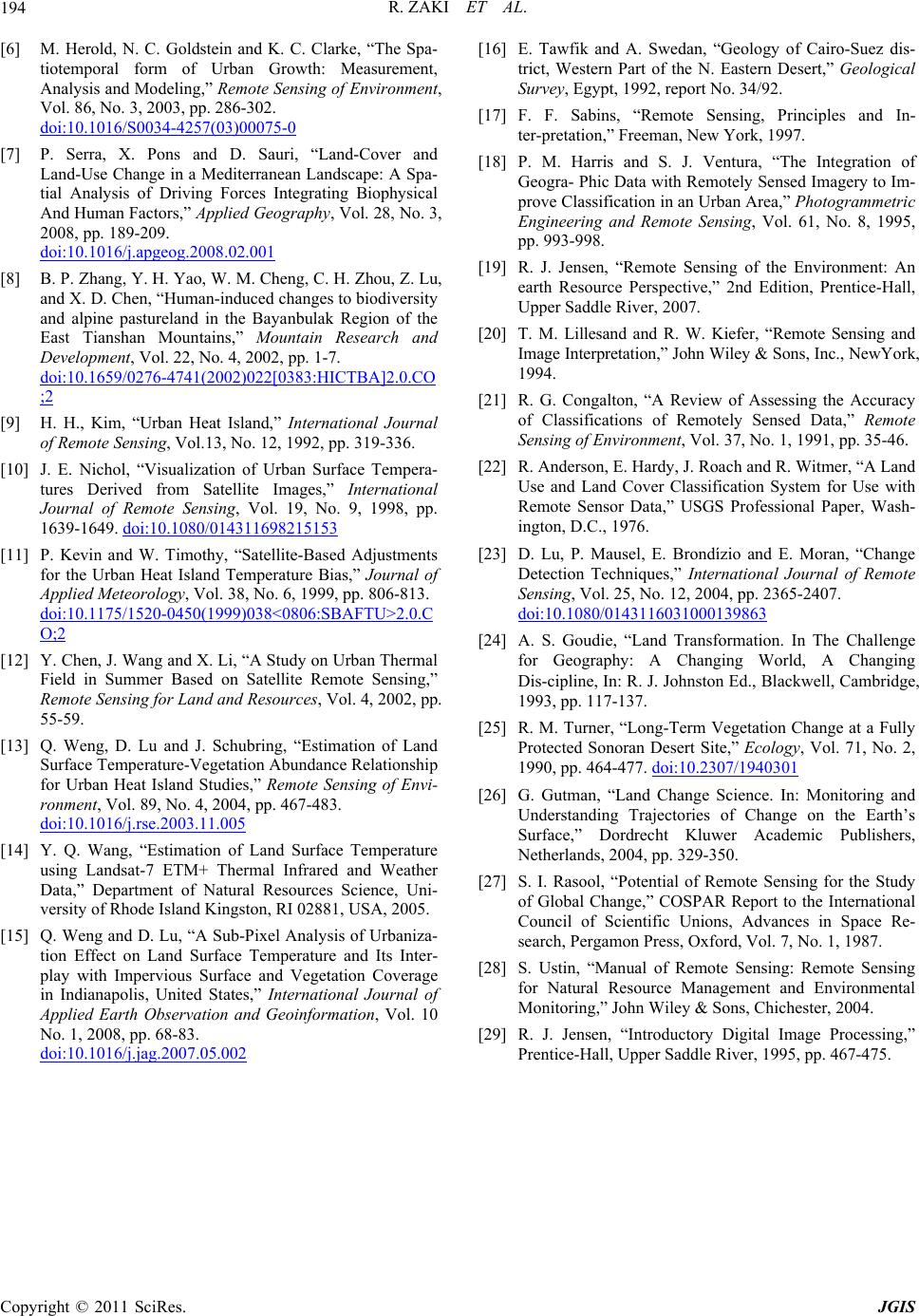
R. ZAKI ET AL.
194
[6] M. Herold, N. C. Goldstein and K. C. Clarke, “The Spa-
tiotemporal form of Urban Growth: Measurement,
Analysis and Modeling,” Remote Sensing of Environment,
Vol. 86, No. 3, 2003, pp. 286-302.
doi:10.1016/S0034-4257(03)00075-0
[7] P. Serra, X. Pons and D. Sauri, “Land-Cover and
Land-Use Change in a Mediterranean Landscape: A Spa-
tial Analysis of Driving Forces Integrating Biophysical
And Human Factors,” Applied Geography, Vol. 28, No. 3,
2008, pp. 189-209.
doi:10.1016/j.apgeog.2008.02.001
[8] B. P. Zhang, Y. H. Yao, W. M. Cheng, C. H. Zhou, Z. Lu,
and X. D. Chen, “Human-induced changes to biodiversity
and alpine pastureland in the Bayanbulak Region of the
East Tianshan Mountains,” Mountain Research and
Development, Vol. 22, No. 4, 2002, pp. 1-7.
doi:10.1659/0276-4741(2002)022[0383:HICTBA]2.0.CO
;2
[9] H. H., Kim, “Urban Heat Island,” International Journal
of Remote Sensing, Vol.13, No. 12, 1992, pp. 319-336.
[10] J. E. Nichol, “Visualization of Urban Surface Tempera-
tures Derived from Satellite Images,” International
Journal of Remote Sensing, Vol. 19, No. 9, 1998, pp.
1639-1649. doi:10.1080/014311698215153
[11] P. Kevin and W. Timothy, “Satellite-Based Adjustments
for the Urban Heat Island Temperature Bias,” Journal of
Applied Meteorology, Vol. 38, No. 6, 1999, pp. 806-813.
doi:10.1175/1520-0450(1999)038<0806:SBAFTU>2.0.C
O;2
[12] Y. Chen, J. Wang and X. Li, “A Study on Urban Thermal
Field in Summer Based on Satellite Remote Sensing,”
Remote Sensing for Land and Resources, Vol. 4, 2002, pp.
55-59.
[13] Q. Weng, D. Lu and J. Schubring, “Estimation of Land
Surface Temperature-Vegetation Abundance Relationship
for Urban Heat Island Studies,” Remote Sensing of Envi-
ronment, Vol. 89, No. 4, 2004, pp. 467-483.
doi:10.1016/j.rse.2003.11.005
[14] Y. Q. Wang, “Estimation of Land Surface Temperature
using Landsat-7 ETM+ Thermal Infrared and Weather
Data,” Department of Natural Resources Science, Uni-
versity of Rhode Island Kingston, RI 02881, USA, 2005.
[15] Q. Weng and D. Lu, “A Sub-Pixel Analysis of Urbaniza-
tion Effect on Land Surface Temperature and Its Inter-
play with Impervious Surface and Vegetation Coverage
in Indianapolis, United States,” International Journal of
Applied Earth Observation and Geoinformation, Vol. 10
No. 1, 2008, pp. 68-83.
doi:10.1016/j.jag.2007.05.002
[16] E. Tawfik and A. Swedan, “Geology of Cairo-Suez dis-
trict, Western Part of the N. Eastern Desert,” Geological
Survey, Egypt, 1992, report No. 34/92.
[17] F. F. Sabins, “Remote Sensing, Principles and In-
ter-pretation,” Freeman, New York, 1997.
[18] P. M. Harris and S. J. Ventura, “The Integration of
Geogra- Phic Data with Remotely Sensed Imagery to Im-
prove Classification in an Urban Area,” Photogrammetric
Engineering and Remote Sensing, Vol. 61, No. 8, 1995,
pp. 993-998.
[19] R. J. Jensen, “Remote Sensing of the Environment: An
earth Resource Perspective,” 2nd Edition, Prentice-Hall,
Upper Saddle River, 2007.
[20] T. M. Lillesand and R. W. Kiefer, “Remote Sensing and
Image Interpretation,” John Wiley & Sons, Inc., NewYork,
1994.
[21] R. G. Congalton, “A Review of Assessing the Accuracy
of Classifications of Remotely Sensed Data,” Remote
Sensing of Environment, Vol. 37, No. 1, 1991, pp. 35-46.
[22] R. Anderson, E. Hardy, J. Roach and R. Witmer, “A Land
Use and Land Cover Classification System for Use with
Remote Sensor Data,” USGS Professional Paper, Wash-
ington, D.C., 1976.
[23] D. Lu, P. Mausel, E. Brondízio and E. Moran, “Change
Detection Techniques,” International Journal of Remote
Sensing, Vol. 25, No. 12, 2004, pp. 2365-2407.
doi:10.1080/0143116031000139863
[24] A. S. Goudie, “Land Transformation. In The Challenge
for Geography: A Changing World, A Changing
Dis-cipline, In: R. J. Johnston Ed., Blackwell, Cambridge,
1993, pp. 117-137.
[25] R. M. Turner, “Long-Term Vegetation Change at a Fully
Protected Sonoran Desert Site,” Ecology, Vol. 71, No. 2,
1990, pp. 464-477. doi:10.2307/1940301
[26] G. Gutman, “Land Change Science. In: Monitoring and
Understanding Trajectories of Change on the Earth’s
Surface,” Dordrecht Kluwer Academic Publishers,
Netherlands, 2004, pp. 329-350.
[27] S. I. Rasool, “Potential of Remote Sensing for the Study
of Global Change,” COSPAR Report to the International
Council of Scientific Unions, Advances in Space Re-
search, Pergamon Press, Oxford, Vol. 7, No. 1, 1987.
[28] S. Ustin, “Manual of Remote Sensing: Remote Sensing
for Natural Resource Management and Environmental
Monitoring,” John Wiley & Sons, Chichester, 2004.
[29] R. J. Jensen, “Introductory Digital Image Processing,”
Prentice-Hall, Upper Saddle River, 1995, pp. 467-475.
Copyright © 2011 SciRes. JGIS